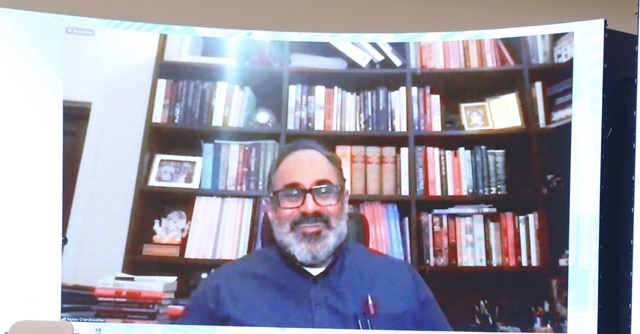
Mint DIS 2023 | India seeks proposals for 40nm chip fabs: Rajeev Chandrashekhar


 The Indian government is inviting applications for 40 nanometer (nm) semiconductor fabs to be set up in the country, Minister of State (MoS), Electronics and IT, Rajeev Chandrashekhar said at the Mint Digital Innovation Summit held in Bengaluru on 9 June. Chips based on 40nm nodes have applications in the automotive sector, networking equipment, medical devices, printers, and in digital cameras.
The Indian government is inviting applications for 40 nanometer (nm) semiconductor fabs to be set up in the country, Minister of State (MoS), Electronics and IT, Rajeev Chandrashekhar said at the Mint Digital Innovation Summit held in Bengaluru on 9 June. Chips based on 40nm nodes have applications in the automotive sector, networking equipment, medical devices, printers, and in digital cameras.
Chandrashekhar said much progress has been made since December 2021 when the scheme for semiconductor manufacturing was originally approved. Earlier, the government was said to be seeking 28nm plants in the country, but Chandrashekhar said that 40nm plants are now being sought.
When asked about the current status of the semiconductor proposals received by the government, Chandrashekhar said, “On the much more difficult issue of starting a silicon and a compound fab, there are proposals that have come. They continue to try and negotiate for the licensing of the manufacturing technology, and whilst they continue the negotiation, in the last few weeks we have opened up for more applications in the more mature nodes of 40 nanometer that go into automotive and wireless in those kinds of applications.”

To be sure, India’s semiconductor manufacturing scheme was announced back in 2021, and the government has received some proposals that are being evaluated already. A joint venture between the Vedanta Group and Taiwanese Foxconn is said to be the frontrunner at the moment, but at least two more proposals have also been received. “I have absolutely no doubt in my mind that we will have an ecosystem of design, packaging, innovation and research in semiconductor rollout over the coming two years in India,” the minister added.
Alongside semiconductors, Chandrashekhar said that the Indian government wants to lay down principles to protect users from potential harms of emerging technologies, be it artificial intelligence (AI) or Web3. “There are certain aspects of user harm, safety and trust of our 1.2 billion Indians who will soon be on the internet, by 2025-26, and that should not be violated,” said Chandrasekhar. He added that the government is looking at all emerging technologies through the “prism of user harm”, and will run consultations for the same. “We will do this in a manner which will allow the bill and the subordinate legislation to rapidly respond if there are new cases of user harm that we do not know today that emerged suddenly tomorrow,” he added.
India is expected to release the first draft of the Digital India Act by the end of July. The new law is expected to replace the current Information Technology Act, 2000. Chandrasekhar said last month that the new law will have a chapter dedicated to emerging technologies, including AI. Chandrashekhar pointed out that India has a huge role to play in how AI develops, and emphasized how the country, as chair of the Global Partnership on Artificial Intelligence (GPAI), is taking this forward. GPAI comprises 25 member countries including the US, the UK, EU, Australia, Canada, France, Germany, Italy, Japan, Mexico, New Zealand, Republic of Korea, and Singapore.

“We will drive the conversation about what ought to be the guardrails for AI, what ought to be the regulation for AI, what ought to be the do(s) and don't(s) in terms of a global protocol almost, and which directions AI must not go,” the minister said, adding India is building a framework for AI that will include three centers of excellence to be developed with deep connections to startups and the industry ecosystem. “We have a framework in place. We are moving ahead with a program that is called India AI. We've had five different working groups including academics and startups, designing many of these pieces. By the end of this month, you will see a comprehensive announcement of the India AI structure, architecture and design,” said Chandrasekhar.
Early this week, PM Modi met OpenAI CEO Sam Altman and discussed opportunities for AI and the need for regulation. Chandrasekhar clarified that the government of India is not going to specifically say which applications they intend to develop. “I'm pretty emphatic that there should be no misunderstanding that the government of India will say we will do a ChatGPT equivalent (referring to reports about the country planning an IndiaGPT). Language translation, healthcare and governance are three very focused areas that are near term in our goals of creating AI models and AI capabilities,” he added.
In addition to the AI program, Chandrasekhar also talked about the role of AI in the India Stack. He pointed out that in addition to greater digitalization of the government and having many additional layers in the India Stack, there will be a layer of AI on top of the India Stack. “We expect the India Stack to become an intelligent stack with integration into the datasets that are being assembled within the government and the learning models,” he added.

Though India started 5G (fifth generation) rollout last year and discussions on 6G (sixth generation) have started, Chandrasekhar acknowledged that there are many pockets of India, especially remote regions that still struggle to be connected to the internet. To address this gap, he assured that eight to six months ago, the government of India launched a special scheme where a minimum of 4G (fourth generation) connectivity will be available in every district, every zone and every block of the country. “So that is being done by BSNL and all the private sector companies funded by a scheme USO (United Service Organizations) within the department of telecom. The idea is by 2023-24, there will be no part of India that is left unconnected without at least a minimum of 4G.”
AI, semiconductors and quantum are the three real cutting-edge tech that India is building rapidly capacity and capability, summed up Chandrasekhar. In April, the Indian government gave its approval to a Rs 6000 core National Quantum Mission (NQM) to develop quantum computers with 50 to 1,000 qubits and scale up R&D in quantum technologies in India over the next eight years. According to Chandrasekhar, quantum is the cutting edge of high-performance computing is basically a “rewriting of the compute paradigm”. “It is no longer the digital world as you know it. and it totally opens up all kinds of possibilities including in the encryption-decryption strategic space,” he added.
